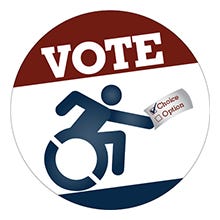By Pamela McAfee
Distributive Organizer & Community Liaison, Grassroots Democrats HQ
Get Out The Vote! It's how we win elections. At the start of a campaign, organizers get lists of low propensity voters with good Democratic support scores. Voters with incorrect phone numbers or bad addresses are soon weeded out. Through each pass through a list we identify supporters until we create our universe of contacts. But we are missing one crucial demographic — people with disabilities.
Every GOTV effort on which I have participated, the leftovers on the list are overwhelmingly persons with disabilities. This includes older voters in congregate living facilities.
To reach ALL voters, I urge organizers to quit focussing on the maladies of an individual and start looking at barriers. The same barriers that create difficulties in daily life also make it hard to vote.
The Problem — Equal Access
The problem with voting lists lies in the assumption that all voters have equal access to polling locations, ballot drop boxes, even voter registration. This simply is not the case for many voters with disabilities and those in congregate living situations.
Voters with disabilities are the largest, most intersectional voting bloc in the US. A Rutgers University survey found that 17.7 million persons with disabilities voted in 2020. A more recent survey by AARP revealed the power of this community.
● Nine out of ten Americans with disabilities over 50 are planning to vote.
● A majority rely on early voting methods and nearly half of voters with disabilities require specific accommodations to vote.
So how can we organizers do a better job at getting out the disabled vote? The first step is acknowledging there is an issue. The next step is to add disabilities into voting plans.
A New Question
In our outreach, I suggest we add a survey question, "Do you foresee any obstacles to voting?" With such information, we can urge campaigns to come up with remedies. Tom Suozzi's campaign should be a model. Organizers made specific plans for Spanish speakers and voters who spoke other languages common in Suozzi’s district. We also had a single point of contact for voters needing rides. Many of those voters needing rides were voters with disabilities.
We aren't going to remove all the barriers. The other side keeps building more obstacles every election cycle. But making voters with disabilities part of the conversation early on will make GOTV much more effective. I am proud to be a visible representative of the disabled community and I encourage you to invite more members of the community to your table. Our motto and our goal is: “Nothing about us without us.”
Here’s What You Can Do
Check with your state's laws on voter assistance in congregate living facilities
Reach out to organizations like The ARC, Centers for Independent Living, or Senior Services
The New Disabled South offers trainings for organizers; Contact them
Learn to use respectful language
Connect with resources like Ride Share 2 Vote or Vote Riders
Encourage campaigns and local parties to have a GOTV plan for voters with disabilities
For further information, check out: https://www.aapd.com/about-rev-up/ or REV UP NC, which my friends and I started.







Thank you everyone who has read and shared this important Substack. It's a little bit funny and serendipitous that the DOJ released guidance on voters with disabilities the day before this article was published.
If you are doing any GOTV work, please start incorporating specific language that might help voters with disabilities
https://www.aapd.com/aapd-applauds-voting-guidance/